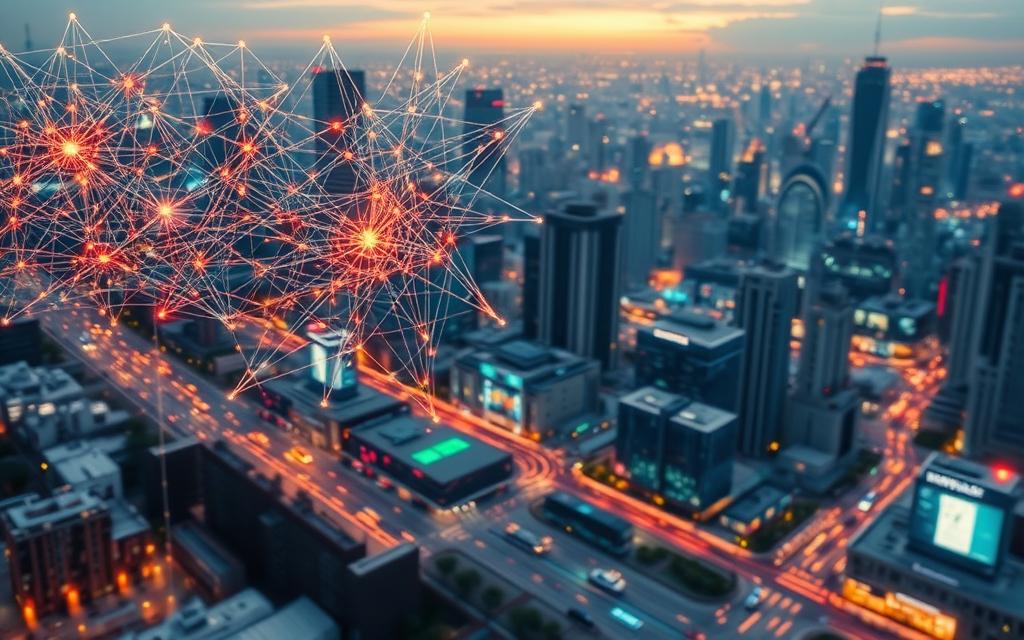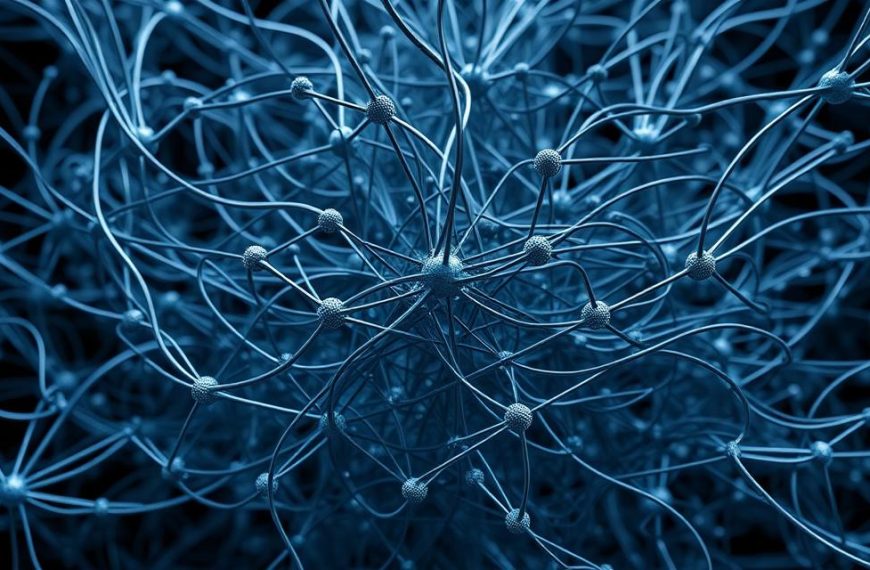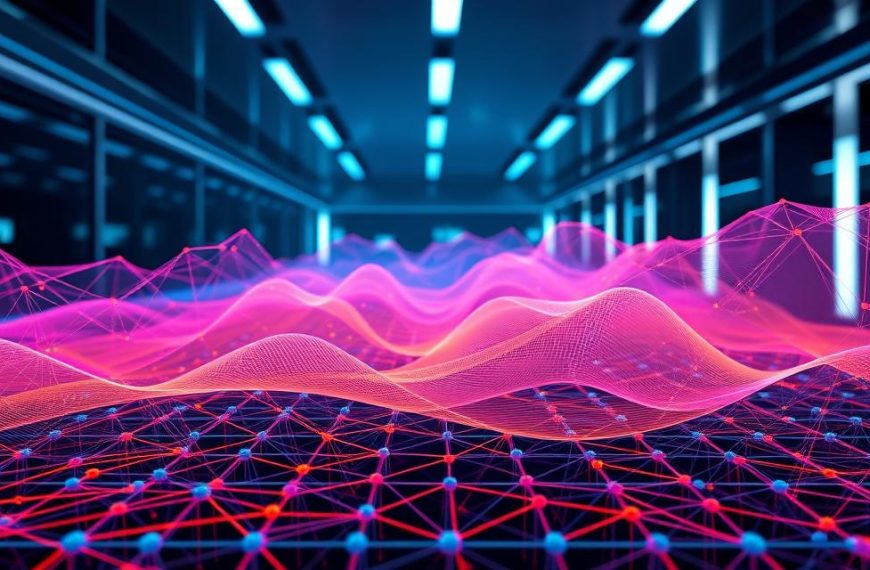Neural networks are transforming industries by powering modern artificial intelligence applications. These advanced systems, rooted in deep learning, enable machines to process complex data and make intelligent decisions. From healthcare to finance, their impact is undeniable.
Major corporations like General Motors, BMW, and NASA are leveraging neural networks to innovate and optimize operations. In healthcare, they assist in diagnosing diseases. In finance, they predict market trends. Manufacturing benefits from improved automation, while entertainment uses them for personalized content.
Emerging fields like agriculture and education are also adopting this technology. Farmers use it to monitor crops, and educators create tailored learning experiences. This article explores practical applications and provides actionable insights for professionals and businesses.
Introduction to Neural Networks
Inspired by the human brain, neural networks drive intelligent systems. These artificial neural networks are designed to process complex data, enabling machines to perform tasks that once required human intervention. Their ability to learn and adapt makes them a cornerstone of modern AI.
What Are Neural Networks?
At their core, neural networks consist of interconnected nodes, or artificial neurons. These nodes mimic the behavior of biological neurons, transmitting signals when activated. The connections between them are weighted, determining the strength of the signal. This structure allows the network to process information in layers, refining it at each step.
How Neural Networks Mimic the Human Brain
The design of neural networks draws heavily from the human brain. Just as biological neurons fire when they receive sufficient input, artificial nodes activate based on predefined thresholds. This layered processing mirrors the way our brains interpret sensory data, making these systems highly efficient at tasks like pattern recognition and decision-making.
“The evolution from simple perceptrons to today’s advanced architectures has been transformative.”
From early models to modern deep learning frameworks, artificial neural networks have undergone significant advancements. Enterprises across industries, as reported by the New York Times, are leveraging this technology to innovate and optimize their operations. Whether it’s healthcare, finance, or manufacturing, the impact of learning systems is undeniable.
The Architecture of Neural Networks
The structure of neural networks plays a pivotal role in their functionality. These systems are built on a layered architecture, each with a specific purpose. From data intake to final results, every layer contributes to the network’s ability to process information efficiently.
Input Layer: The Gateway of Data
The input layer serves as the entry point for data. It handles initial analysis and categorization, ensuring the information is ready for further processing. This layer normalizes data and encodes features, preparing it for the next stage.
Hidden Layers: The Core of Processing
Hidden layers are where the magic happens. These layers perform progressive feature extraction through weighted transformations. Using activation functions, they refine data at each step, enabling the network to learn complex patterns.
Output Layer: Delivering the Results
The output layer provides the final results, whether it’s classification or regression. Depending on the task, this layer can deliver binary or multi-class outputs. For example, in KodaCloud’s Wi-Fi optimization, the output layer determines the best network configuration.
Shallow architectures, with fewer hidden layers, are often used for simpler tasks. In contrast, deep architectures excel in complex scenarios, such as manufacturing quality control, where precision is critical. Understanding these layers helps professionals harness the full potential of neural networks.
Deep Neural Networks: Taking It to the Next Level
Deep neural networks redefine complexity in modern AI systems. These architectures contain millions of neurons spread across numerous layers, enabling them to handle intricate tasks with precision. Unlike traditional models, they excel in feature abstraction, making them ideal for applications like image recognition and natural language processing.
What Makes Deep Neural Networks Different?
The depth of these networks sets them apart. With multiple hidden layers, they can process data hierarchically, extracting high-level features from raw inputs. This capability is crucial for tasks like the Dawn drone platform’s cortical emulation, where complex environmental data must be interpreted in real-time.
Training deep architectures requires extensive datasets and computational resources. However, the results are transformative. For instance, in medical imaging, deeper layers enable the detection of subtle anomalies that simpler models might miss.
The Role of Weights in Deep Learning
Weights are the backbone of deep learning. They determine how signals are amplified or attenuated between nodes, influencing the network’s output. Proper initialization and optimization of these weights are critical for achieving accurate results.
Techniques like gradient descent help fine-tune weights during training. This process ensures the network learns efficiently, minimizing errors over time. In applications like autonomous driving, optimized weights enable vehicles to make split-second decisions based on sensor data.
While deep networks demand more resources, their ability to handle complex tasks justifies the investment. From healthcare to aerospace, they are driving innovation across industries, proving their value in the AI landscape.
What Can You Do with Neural Networks?
From detecting diseases to predicting market trends, neural networks are reshaping how industries operate. These advanced systems excel at processing complex data, enabling breakthroughs in various fields. Let’s explore some of their most impactful applications.
Image Recognition and Computer Vision
Image recognition is one of the most prominent uses of neural networks. In healthcare, systems like skin cancer detection apps achieve 94% sensitivity, identifying melanoma with remarkable accuracy. This technology is also transforming industries like retail and security, where visual data analysis is critical.
Natural Language Processing and Speech Recognition
Natural language processing (NLP) powers systems that understand and generate human language. Real-time translation tools process semantic patterns, breaking language barriers. Additionally, speech recognition enables voice-activated assistants and customer service chatbots, enhancing user experiences.
Predictive Analytics and Forecasting
Neural networks are revolutionizing predictive analytics. Financial institutions use these models to assess credit risk, while supply chain managers rely on time-series forecasting to optimize operations. Case studies, like OKRA’s healthcare predictions, demonstrate the potential of these systems to transform decision-making.
From fraud detection in banking to personalized learning in education, neural networks are driving innovation across sectors. Their ability to process and analyze vast amounts of data ensures they remain at the forefront of technological advancement.
Engineering Applications of Neural Networks
Engineering industries are leveraging advanced systems to enhance efficiency and precision. From aerospace to robotics, these technologies are driving innovation and solving complex challenges. Let’s explore how they are transforming key sectors.
Neural Networks in Aerospace and Automotive Industries
In the aerospace sector, systems like aircraft fault detection improve maintenance efficiency by 40%. Recurrent neural networks power flight control, ensuring safer and more reliable operations. Companies like Aeiou.tech use these models for drone navigation, enabling precise autonomous flights.
The automotive industry benefits from powertrain optimization. BMW employs neural networks to enhance engine performance and fuel efficiency. These systems analyze vast datasets, providing actionable insights for vehicle design and manufacturing.
Neural Networks in Manufacturing and Robotics
In manufacturing, welding quality analysis achieves 99.8% accuracy. Neural networks monitor production lines, identifying defects in real-time. This reduces waste and ensures high-quality outputs.
Robotics applications include trajectory control in automated warehouses. These systems optimize movement paths, improving efficiency and reducing operational costs. KodaCloud’s Wi-Fi optimization also demonstrates how neural networks enhance connectivity in industrial settings.
| Industry | Application | Impact |
|---|---|---|
| Aerospace | Aircraft Fault Detection | 40% Maintenance Efficiency |
| Automotive | Powertrain Optimization | Enhanced Engine Performance |
| Manufacturing | Welding Quality Analysis | 99.8% Accuracy |
| Robotics | Trajectory Control | Improved Warehouse Efficiency |
These examples highlight the versatility of neural networks in engineering. From predictive maintenance in oil pipelines to advanced systems in robotics, their applications are reshaping industries worldwide.
Business Applications of Neural Networks
Businesses across the globe are harnessing the power of advanced systems to drive innovation and efficiency. From optimizing operations to enhancing customer experiences, these technologies are reshaping industries. Let’s explore how they are applied in key areas like marketing and risk management.
Neural Networks in Marketing and Customer Segmentation
In the realm of marketing, neural networks are revolutionizing how companies engage with their audiences. They enable precise customer segmentation, allowing businesses to tailor campaigns to specific demographics. For instance, dynamic pricing models in e-commerce leverage these systems to adjust prices in real-time based on demand and competition.
Churn prediction in telecom companies is another area where these technologies excel. By analyzing user behavior, they identify at-risk customers, enabling proactive retention strategies. This approach not only improves customer satisfaction but also boosts revenue.
Fraud Detection and Risk Management
Fraud detection is a critical application of neural networks in the business world. MasterCard, for example, has reduced false positives by 55% using these systems. Real-time payment fraud prevention ensures secure transactions, protecting both businesses and consumers.
In risk management, hedge fund analytics powered by deep learning provide actionable insights. These models analyze vast datasets to predict market trends, enabling informed investment decisions. Workforce optimization in Fortune 500 companies also benefits from these technologies, improving productivity and efficiency.
From enhancing hiring processes to safeguarding financial transactions, neural networks are proving indispensable in modern business operations. Their ability to process and analyze complex data ensures they remain at the forefront of innovation.
Neural Networks in Healthcare
Healthcare is experiencing a revolution, driven by advanced systems that enhance accuracy and efficiency. These technologies are transforming how professionals approach medical diagnosis, treatment planning, and drug discovery. By analyzing complex patterns, they enable faster and more precise decision-making.
Medical Diagnosis and Treatment Planning
Neural networks are reshaping medical diagnosis by identifying subtle anomalies in patient data. For instance, the SkinVision app processes 1.2 million user scans with 94% accuracy, detecting skin cancer early. Similarly, the Mayo Clinic uses artificial neural networks for ECG anomaly detection, improving cardiac care.
These systems also excel in tumor segmentation within MRI scans, providing detailed insights for oncologists. Personalized treatment recommendation engines leverage patient data to suggest tailored therapies, enhancing outcomes. Case studies, like OKRA’s cancer treatment predictions, demonstrate their potential to revolutionize oncology.
Neural Networks in Drug Discovery
In drug discovery, neural networks are reducing development timelines by 18 months. They analyze protein folding patterns, accelerating the identification of potential drug candidates. This approach is particularly valuable in pharmaceutical research, where speed and precision are critical.
Genome analysis applications further highlight their versatility. By decoding genetic data, these systems enable researchers to understand disease mechanisms better. This paves the way for innovative treatments and personalized medicine, marking a new era in healthcare.
Neural Networks in Finance
The finance sector is leveraging advanced systems to optimize operations and enhance decision-making. These technologies are transforming how professionals approach trading, risk management, and customer service. By analyzing complex patterns, they enable faster and more precise strategies.
Algorithmic Trading and Portfolio Management
In algorithmic trading, systems like JP Morgan’s LOXM execute trades at optimal market conditions. These models analyze vast amounts of data, identifying trends and opportunities in real-time. High-frequency trading algorithms process millions of transactions per second, ensuring maximum efficiency.
Robo-advisor platforms, powered by recurrent neural networks (RNNs), are reshaping portfolio management. They provide personalized investment strategies based on individual risk profiles and market conditions. This approach democratizes access to sophisticated financial tools, benefiting both institutions and individual investors.
Credit Scoring and Loan Approval
Credit scoring models have evolved with the integration of alternative data analysis. FICO scores now incorporate non-traditional metrics, such as utility payments and rental history, to assess creditworthiness more accurately. This shift has expanded access to credit for underserved populations.
Loan default prediction systems achieve 92% accuracy in major banks. These models analyze historical patterns and borrower behavior, enabling lenders to make informed decisions. Mortgage approval automation further streamlines the process, reducing processing times and improving customer satisfaction.
- Analyze high-frequency trading algorithms
- Discuss robo-advisor platforms using RNNs
- Explore alternative credit scoring models
- Present mortgage approval automation systems
- Examine cryptocurrency price prediction models
From optimizing trading strategies to enhancing credit assessments, neural networks are driving innovation in finance. Their ability to process and analyze complex data ensures they remain at the forefront of technological advancement.
Neural Networks in Telecommunications
Telecommunications is undergoing a significant transformation, driven by advanced technologies that enhance connectivity and efficiency. These innovations are reshaping how networks operate, ensuring seamless communication across the globe. From optimizing bandwidth to enabling real-time language translation, the impact is profound.
Network Optimization and Fault Management
Network optimization is a critical application in telecommunications. KodaCloud’s self-healing networks, for instance, reduce downtime by 80%. These systems use advanced algorithms to allocate bandwidth efficiently, ensuring uninterrupted service.
Fault management is another area where these technologies excel. By analyzing network traffic patterns, they predict and resolve issues before they escalate. AT&T’s network traffic prediction models are a prime example, enhancing reliability and performance.
Real-Time Language Translation
Real-time translation is revolutionizing global communication. Skype Translator supports 60 languages with 95% accuracy, breaking language barriers in business and personal interactions. This technology processes speech patterns instantly, enabling smooth multilingual conversations.
Multilingual customer support systems also benefit from these advancements. By integrating processing capabilities, they provide instant responses in the user’s preferred language, improving customer satisfaction.
| Application | Technology | Impact |
|---|---|---|
| Network Optimization | Self-Healing Networks | 80% Downtime Reduction |
| Fault Management | Traffic Prediction Models | Enhanced Reliability |
| Real-Time Translation | Skype Translator | 95% Accuracy |
| Customer Support | Multilingual Systems | Improved Satisfaction |
“The integration of advanced systems in telecommunications is not just an upgrade; it’s a revolution.”
From optimizing 5G network slicing to managing IoT devices, these technologies are setting new standards in the industry. Their ability to process and analyze vast amounts of data ensures they remain at the forefront of innovation.
Neural Networks in Education
Education is evolving rapidly, thanks to innovative technologies that personalize learning experiences. These advancements are helping educators tailor instruction to individual needs, ensuring better outcomes for students. By analyzing patterns in data, these systems are transforming traditional methods into more effective and engaging approaches.
Adaptive Learning Systems
Adaptive learning platforms are at the forefront of this transformation. For example, Coursera’s course recommendations have increased completion rates by 35%. These systems analyze student behavior to provide personalized content, ensuring learners stay engaged and motivated.
Language learning apps are another great example. They use neural networks to personalize vocabulary drills, making the process more efficient. Platforms like Carnegie Learning’s MATHia and DreamBox have shown improvements in mathematics and reading scores of up to 30%.
Student Performance Analysis
Predictive models are helping educators identify at-risk students up to six weeks earlier. By analyzing patterns in data, these systems provide actionable insights to improve student outcomes. For instance, immediate feedback systems have shown a 20% higher retention rate compared to delayed feedback.
Automated essay scoring and plagiarism detection are also advancing. These tools not only save time but also ensure fairness and accuracy in assessments. Predictive analytics can identify at-risk students with success rates of up to 85%, preventing dropout and improving overall performance.
“The integration of advanced systems in education is not just an upgrade; it’s a revolution.”
- Explore competency mapping algorithms
- Discuss automated essay scoring systems
- Analyze classroom engagement monitoring
- Present plagiarism detection advancements
- Examine lifelong learning platforms
For more insights on how neural networks are driving educational innovation, visit this detailed analysis.
Neural Networks in Entertainment
The entertainment industry is embracing cutting-edge technologies to enhance user experiences. From personalized content recommendation systems to immersive gaming environments, these innovations are reshaping how audiences interact with media. By analyzing user patterns, these systems deliver tailored experiences that keep users engaged and satisfied.
Content Recommendation Systems
Platforms like Netflix and Spotify are leading the way in content recommendation. Netflix’s recommendation engine saves the company $1 billion annually by suggesting shows and movies based on viewing patterns. Similarly, Spotify’s Discover Weekly algorithm curates playlists that align with individual music preferences, increasing user retention.
These systems rely on advanced learning models to process vast amounts of data. By understanding user behavior, they predict what content will resonate most, ensuring a personalized experience. This approach not only enhances user satisfaction but also drives revenue growth for platforms.
Neural Networks in Gaming
The gaming industry is leveraging these technologies to create more immersive experiences. NVIDIA’s DLSS (Deep Learning Super Sampling) improves frame rates by up to 300%, delivering smoother gameplay. Procedural content generation in RPGs like No Man’s Sky uses patterns to create endless worlds, keeping players engaged for hours.
AI-generated music compositions are also making waves, with some tracks entering the Billboard charts. Deepfake technology is transforming film production, enabling realistic digital doubles of actors. These advancements are pushing the boundaries of creativity and innovation in entertainment.
- Analyze Spotify’s Discover Weekly algorithms
- Discuss procedural content generation in RPGs
- Explore deepfake technology in film production
- Present esports analytics platforms
- Examine VR environment rendering optimizations
“The integration of advanced systems in entertainment is not just an upgrade; it’s a revolution.”
From personalized recommendations to groundbreaking gaming experiences, these technologies are setting new standards in the industry. Their ability to process and analyze complex data ensures they remain at the forefront of innovation.
Neural Networks in Agriculture
Modern agriculture is witnessing a technological revolution, driven by advanced systems that enhance productivity and sustainability. These innovations are transforming traditional farming practices, enabling farmers to make data-driven decisions. From crop monitoring to pest control, the applications are reshaping the industry.
Crop Monitoring and Yield Prediction
Satellite image analysis is revolutionizing how farmers monitor their fields. By processing multispectral data, these systems predict yields with 97% accuracy. This allows farmers to plan harvests more effectively and optimize resource allocation.
Drone-based systems are another game-changer. They detect crop diseases up to two weeks earlier than traditional methods. This early detection minimizes losses and ensures healthier crops. Precision irrigation systems, powered by soil sensors, save up to 40% water, making farming more sustainable.
Pest Control and Disease Detection
Autonomous harvesting robots are reducing labor costs and increasing efficiency. These robots use advanced data processing to identify ripe crops and harvest them with precision. Commodity price forecasting models also benefit from these technologies, helping farmers make informed decisions.
Precision fertilizer application systems ensure nutrients are distributed evenly, improving crop health. Livestock health monitoring solutions are also advancing, using image analysis to detect early signs of illness in animals. These innovations are making agriculture more efficient and sustainable.
| Application | Technology | Impact |
|---|---|---|
| Crop Monitoring | Satellite Image Analysis | 97% Yield Prediction Accuracy |
| Disease Detection | Drone-Based Systems | 2 Weeks Early Detection |
| Irrigation | Soil Sensors | 40% Water Savings |
| Pest Control | Autonomous Robots | Increased Efficiency |
“The integration of advanced systems in agriculture is not just an upgrade; it’s a revolution.”
Challenges and Limitations of Neural Networks
While neural networks offer groundbreaking capabilities, they also come with significant challenges and limitations. These problems range from high data requirements to ethical concerns, which must be addressed to fully harness their potential.
Data Requirements and Training Time
Deep networks often require 1000x more data than traditional machine learning models. This vast need for information can be a barrier, especially for industries with limited datasets. Additionally, the training process is time-consuming and computationally expensive, often requiring specialized hardware.
Transformer models, for example, demand significant computational resources. This not only increases costs but also raises concerns about energy consumption. Balancing efficiency with accuracy remains a critical challenge for developers.
Interpretability and Ethical Concerns
One of the most pressing problems is the lack of interpretability in neural networks. The FDA mandates explainability for medical AI systems, as opaque models can lead to mistrust and potential risks. Ensuring transparency is essential for widespread adoption.
Ethical concerns also arise, particularly in cases like Amazon’s biased hiring algorithm. Fairness audits in credit scoring systems and GDPR compliance are becoming increasingly important to address these issues. Model distillation techniques are being explored to simplify complex systems without sacrificing performance.
“The integration of advanced systems must prioritize transparency and fairness to gain public trust.”
- Discuss computational costs of transformer models
- Analyze fairness audits in credit scoring systems
- Explore model distillation techniques
- Present GDPR compliance challenges
- Examine energy consumption concerns
Future Prospects of Neural Networks
The future of artificial intelligence is being shaped by groundbreaking advancements in neural network technologies. These innovations are paving the way for smarter, more efficient solutions across industries. From energy-efficient chips to self-supervised learning, the possibilities are expanding rapidly.
Advancements in Neural Network Architectures
Neuromorphic chips are leading the charge, achieving 100x energy efficiency gains. These chips mimic the human brain’s structure, enabling faster and more sustainable processing. Meta’s self-supervised learning models are another leap forward, reducing labeling costs by 90% and making AI more accessible.
Quantum neural networks are entering the experimental phase, promising unprecedented computational power. These architectures could solve complex problems in seconds, revolutionizing fields like cryptography and material science. Liquid neural networks are also gaining traction, offering adaptive control for dynamic environments.
- Explore brain-computer interface advancements for seamless human-AI interaction.
- Analyze federated learning developments to enhance data privacy and security.
- Present synthetic data generation breakthroughs for training robust models.
The Role of Neural Networks in AI Evolution
Neural networks are at the heart of AI’s evolution, driving innovations that redefine intelligence. Self-supervised learning models are reducing reliance on labeled data, making AI more scalable. Federated learning is enabling collaborative model training without compromising data privacy.
AI safety research is also gaining momentum, ensuring that these systems operate ethically and transparently. As solutions become more advanced, the focus is shifting toward creating AI that aligns with human values and societal needs.
“The integration of neural networks into AI evolution is not just an upgrade; it’s a transformation.”
From energy-efficient architectures to ethical AI development, the future of neural networks is bright. These advancements are setting the stage for a new era of intelligence, where technology and humanity work hand in hand.
Conclusion
The transformative power of advanced AI systems is reshaping industries globally. From healthcare to agriculture, these applications are driving innovation and efficiency. Cloud-based AI services are making these technologies more accessible, enabling businesses of all sizes to leverage their potential.
Investments in infrastructure, such as high-performance computing and data storage, are essential to support these advancements. The future will likely see a convergence with IoT and blockchain, creating even more robust solutions.
As these technologies evolve, responsible innovation frameworks will be crucial. Ensuring ethical use and transparency will build trust and maximize the benefits of AI intelligence. The journey ahead promises exciting possibilities for industries and society alike.












